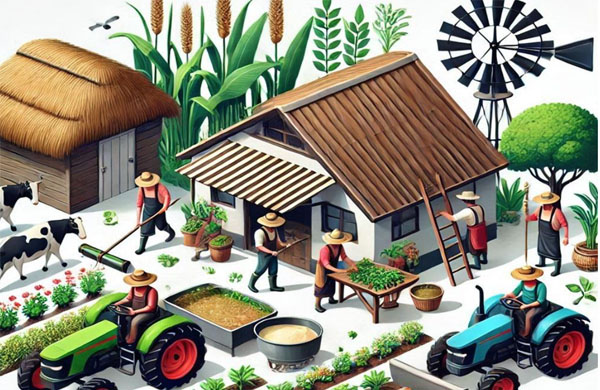How Traditional Farming is Adapting to Modern Demands in 2025
By Space Coast Daily // December 20, 2024

Traditional farming has long been the backbone of agriculture, relying on time-tested methods passed down through generations.
However, as global demands for food increase and environmental challenges grow more pressing, traditional farmers are finding innovative ways to adapt. By integrating modern technology and sustainable practices, these farmers are bridging the gap between heritage and progress to meet the needs of a changing world.
Here are some of the ways traditional farming is adapting to modern demands in 2025.
Sustainable Practices
Traditional farmers have always been stewards of the land, but in recent years they have begun to adopt more sustainable practices to preserve and protect their farms for future generations. This includes implementing conservation methods such as crop rotation, cover cropping, and reducing chemical inputs.
By doing so, these farmers are minimizing their impact on the environment while also improving soil health and increasing yields. According to Tastewise, a food intelligence company, sustainability is expected to be the top trend in the food industry by 2025. As consumers become more conscious about their food choices, traditional farmers who practice sustainable methods will have a competitive edge.
Precision Agriculture
Precision agriculture uses technology and data to improve farming efficiency. With advanced tools like GPS mapping, soil sensors, and drones, farmers can monitor soil health, moisture, crop conditions, and weather in real-time. This helps them make smarter decisions about irrigation, fertilization, and pest control, tailoring efforts to their crops’ needs. By using resources more efficiently, farmers can reduce waste, lower costs, minimize environmental impact, and boost yields. These innovations are transforming farming, offering a sustainable way to meet growing global food demand while conserving resources.
Leading Traditional Farming Expected in 2025
The food industry is poised for significant shifts in 2025 as consumers and markets prioritize health, sustainability, and innovation. One major trend is the emphasis on organic and locally grown produce, driven by the increased demand for transparency and reduced carbon footprints. Consumers are seeking products that connect them directly to the source, giving traditional farmers an opportunity to thrive by focusing on authentic, high-quality goods.
Plant-based diets are also gaining momentum as one of the leading food trends, with a growing number of consumers choosing to reduce or eliminate animal products from their diets. This shift is driven by concerns over environmental impact, animal welfare, and personal health. As a result, traditional farmers who specialize in producing plant-based foods will have a significant advantage in the market.
The Role of Sustainable Farming
Sustainable farming practices are crucial in meeting the demands of consumer trends and ensuring long-term food security. By using methods that promote soil health, conserve water resources, and protect biodiversity, sustainable farming can help mitigate the effects of climate change on agriculture. It also plays a critical role in reducing carbon emissions and promoting ecological balance.
Furthermore, sustainable farming has proven to be economically beneficial for farmers. By reducing input costs and improving crop yields, sustainable practices can increase profits for traditional farmers while also reducing their environmental impact.
The Importance of Innovation
Innovation is essential for tackling the challenges and opportunities of shifting consumer demands and sustainable farming. As concerns about environmental impact and resource efficiency grow, farmers must adopt new technologies to stay competitive. Tools like precision agriculture, which uses GPS and data to optimize planting and harvesting, are transforming crop production by reducing waste and increasing yield. Vertical farming and hydroponics are also changing agriculture, enabling crops to grow in controlled environments with less water and land while producing fresh food year-round.
Innovation is equally important in addressing issues like plastic pollution. Biodegradable plastics and compostable packaging offer sustainable alternatives, helping farmers reduce environmental impact and cater to eco-conscious consumers.
Wrap Up
In conclusion, the future of traditional farming lies in embracing innovation and sustainable practices. By utilizing new technologies and techniques, farmers can increase their profits while also reducing their environmental impact. But it’s not just about meeting consumer demands; innovation is also essential for addressing global challenges like climate change and resource scarcity. From precision agriculture to eco-friendly packaging solutions, there are countless ways for traditional farmers to modernize their operations and pave the way towards a more sustainable future for our planet.












